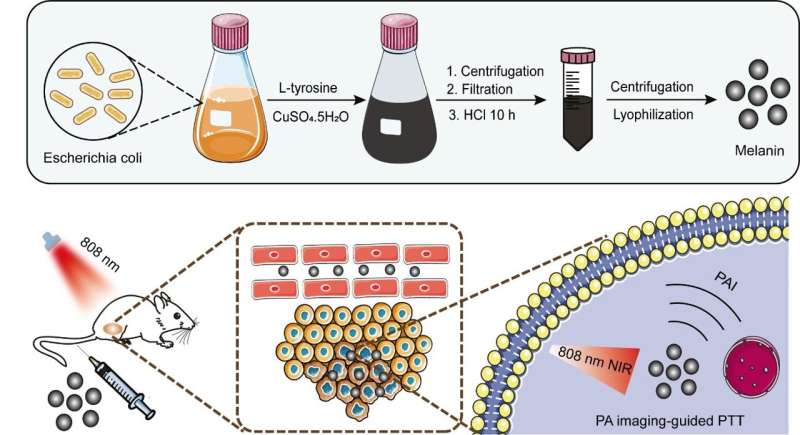This article has been reviewed according to Science X's editorial process and policies. Editors have highlighted the following attributes while ensuring the content's credibility:
fact-checked
peer-reviewed publication
trusted source
proofread
Genetically engineered bacterium enables biosynthesis of melanin nanoparticles

Photothermal therapy (PTT) has attracted considerable attention for the treatment of tumors because it is minimally invasive and has spatiotemporal selectivity.
Melanin is a kind of multifunctional pigment found widely in mammals, plants and microbes, with great prospects as a PTT agent for cancer treatment. Unfortunately, commercially available melanin is mainly obtained by chemical synthesis or extraction from sepia, which hinders its large-scale production and causes some potential safety hazards.
Recently, a research team led by Prof. Yan Fei from the Shenzhen Institute of Advanced Technology (SIAT) of the Chinese Academy of Sciences, together with Prof. Lin Jing from Shenzhen University and Prof. Xu Xiaohong from Guangdong Medical University, heterologously expressed a tyrosinase gene in Escherichia coli to synthesize melanin nanoparticles under mild and environmentally friendly conditions.
This work was published in Small on Dec. 29.
The biosynthetic melanin nanoparticles exhibited excellent biocompatibility, good stability, and negligible toxicity. "They had strong absorption in the near-infrared region and higher photothermal conversion efficiency (48.9%) than chemically synthesized melanin-like polydopamine nanoparticles under an 808-nm laser irradiation," said Prof. Yan.
The researchers further evaluated the photoacoustic imaging performance and antitumor efficacy of biosynthetic melanin nanoparticles. The results showed that the biosynthetic melanin nanoparticles had excellent photoacoustic imaging performance and could be used for photoacoustic imaging-guided photothermal therapy in vivo.
"Our study provided an alternative approach to synthesize PTT agents with broad application potential in the diagnosis and treatment of cancer," said Prof. Yan.
More information: Meijun Fu et al, Biosynthesis of Melanin Nanoparticles for Photoacoustic Imaging Guided Photothermal Therapy, Small (2022). DOI: 10.1002/smll.202205343
Journal information: Small
Provided by Chinese Academy of Sciences





















